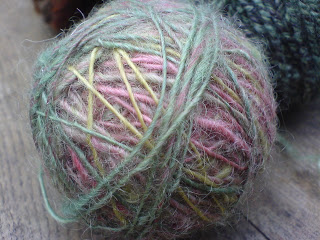About this blog space
This blog space is a place for me to primarily put all my wool gatherings, adventures, experiments. I am now a mum of two astounding daughters, and I used to be a DIY musician and co-ran a tiny independent label (Slampt), so this punk can-do attitude plus feminist analysis and Art school experience somehow informs my wool work! I am also deeply moved by GREEN, trees, weather, colour combinations in nature, and texture. I aim to source wool from round the corner or at the very least UK grown and processed, and to create no toxic waste. This means I get to see sheep as often as I can, sometimes at wool fests.
I am on Ravelry and Etsy as FatHenWildWool and Facebook as Rachel Holborow.
I am on Ravelry and Etsy as FatHenWildWool and Facebook as Rachel Holborow.
Monday, 3 January 2011
Logwood dyeing
Strangely, all of the above fibres are dyed with logwood. As is often the case with plant dyes, if you process them differently, you get different effects. Logwood (usually bought as a powder or chippings from dye suppliers) I have found, produces colours ranging from red to magenta to purple to brown.
Red was obtained by solar dyeing the fibres (cotswold wool) in a large Kilner jar, using rain water. The chippings of logwood were put in the bottom of the jar on our East facing window sill in the hieght of sunny summer for a week, unmordanted wool and water were added.A bold red resulted!
This red wool when immersed for 30 mins in water with washing soda added turned magenta, excitingly!
A deep purple was obtained from (hard) tap water with Alum dissolved in it, soaking the logwood chips in it over night and then slowly heating it to simmer twice. The chips were strained off. The dye liquor was allowed to cool, then wool was added and heated up to simmer twice, slowly. I left it in overnight, and a vibrant purple resulted.
The same logwood chips were allowed to soak overnight with tap water and Vinegar ( a whole bottle!), and in a similar process to before, I obtained a deep brown.
The logwood in the photos above has made the purple, brown and pinky red.
Aparentally it can also make blue. And I find it is a reasonably priced dyestuff too.
Labels:
Logwood,
plant dyed,
wool
Subscribe to:
Post Comments (Atom)



It does fade though, sometimes quite badly in bright sunlight. This is why when logwood started being imported from the New World, it was quickly either banned or taxed, as it was used to dye blue as a substitute for the much more lightfast (and more expensive) indigo.
ReplyDeleteAnother exciting experiment I tried with logwood which gave brilliant results as the purple shade was just gorgeous, I dissolved some of hue & dye logwood in an old enamel wash basin with citric acid granuels left to go cold. Topped up with luke warm water and gave a good stir. Then I put in some Falkland fibre, about 120g just coiled round and around until it was all in and submerging under the water. Left for two hours possibly slightly longer.
ReplyDeleteNext I placed the basin in the empty bath with the plug in and turned on the hot tap and allowed the water to fill in the bath until the basin was floating. Shut the door and left it over night then did the same thing in the morning.
Leave to go completely cold.
When I went back in about seven to eight hours later the water had completely exhausted, not a trace of any colour left in the basin and the fibre was a beautiful purple not plum like it was actual heather or lavender type purple.
Washing the fibre I used a bit of hand hot water with washing soda, it was colour fast nothing came out.
I also have done this experiment with teal Hue & Dye extract and it worked in much the same way but instead of the washing soda I washed with some lemon juice in the water which seemed to brighten it all up nicely.
Loving your experiments :)
Helen xx
Great, thanks Freyalyn and Helen. A real wealth of knowledge building up here, for me if no one else!
ReplyDeleteDoes anyone know of anything you can do about non light fastness. I have found that Turmeric can fade some times? Cool wash with salt seems to help...
Tumeric will only fade so far, then its lightfast and washfast. Its one of those magical dye stuffs that looks nicer with age, well more mellow anyway.
ReplyDeleteNatural dyes take on a whole new appearance with a little bit of fading in the light over time :)
What a wonderfully positive way to look at it! Dyes that improving with ageing, like whisky... I think I may use that idea and disseminate it!
ReplyDelete